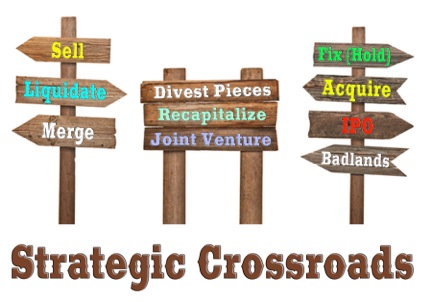Image may be NSFW.
Clik here to view. Imagine the scene: the CEO and a collection of company shareholders, directors and senior management team members have piled into their corporate Covered Prairie Wagon. The wagon is lumbering down the winding, bumpy, rutted path called the Shareholder Value Road.
Imagine the scene: the CEO and a collection of company shareholders, directors and senior management team members have piled into their corporate Covered Prairie Wagon. The wagon is lumbering down the winding, bumpy, rutted path called the Shareholder Value Road.
Or…instead of a crowded, hot Prairie Wagon (did the Pioneers hang those ‘Little Trees’ air fresheners…), maybe it’s just you bouncing along in your own personal buckboard.
No matter what you’re driving, at some point on the journey all corporate wagons come to a major crossroad – a Strategic Crossroad. Generally, more than one Strategic Crossroad is encountered on the long Shareholder Value Road. You can hit them:
- early in the adventure
- at a mature midpoint
- unexpectedly
- and/or near the end of the trail
Whatever the natural stopping point, critical choices have to be made – you (and your traveling companions) have to pick a direction and move on. Chances are you will have to ‘make camp’ for a bit while the directional choices are identified, evaluated, debated, argued, rejected and decided. In some extended encampments, the travellers may need a lot of provisions!
There could be many signs in front of you…
Image may be NSFW.
Clik here to view. Business press releases offer repetitious stories about strategic choices/alternatives found on the Shareholder Value Road all the time. The public company stories are generally presented in a very clinical light. Here are a couple of examples from well known companies:
Business press releases offer repetitious stories about strategic choices/alternatives found on the Shareholder Value Road all the time. The public company stories are generally presented in a very clinical light. Here are a couple of examples from well known companies:
Press Release #1:
“Famous Example #1, a world leader in the communications market, today announced that the Company’s Board of Directors has formed a Special Committee to explore strategic alternatives to enhance value and increase scale. These alternatives could include, among others, possible joint ventures, strategic partnerships or alliances, a sale of the Company or other possible transactions.”
Press Release #2:
“Famous Example #2 today announced that its Board of Directors has initiated a process to explore and evaluate a broad range of strategic alternatives for the Company to enhance shareholder value. The Company strongly believes in its current business strategy but does not believe that its current share price accurately reflects its strong balance sheet, the value of its signed license agreements, its business prospects or the residual value of its broad intellectual property portfolio. Strategic alternatives to be considered may include changes to the Company’s dividend policy or other forms of return of capital to shareholders, the acquisition or disposition of assets, joint ventures, the sale of the Company, alternative operating models or continuing with the current business plan, among other potential alternatives.”
What are your thoughts after reading both of these examples?
Should the evaluation of strategic choices be a clinical, orderly, boilerplate process? Will a thick Excel model prepared by the Investment Bankers and loaded with lots of links suffice? Nope.
Is the evaluation of strategic choices a layered process? Yes.
IMHO there are ‘Six Layers’ that need to be understood separately and collectively in order to make and implement the most appropriate choice at the time. The Six Layers are:
- The Attitude of the shareholders/owners
- The Motivation of the shareholders/owners
- The Company’s Place
- The Business Model
- The Financial Condition
- The Capabilities of the CEO and management team
This is Part One of a collection of disguised stories about how a cross section of companies (early stage, mature, PE/VC backed, public, privately-held and family-owned) hit their own Strategic Crossroad and found a way to make the best available choice. I was at the crossroads encampment with all, either as an operating executive, a board member or an outside strategic advisor.
Why is this relevant? What’s the ‘So What’ in deciding to do this series and why have I mentioned a couple of times above ‘the best available choice at the time’? This isn’t a perfect science. The So What hopefully will illustrate how the interplay of the Six Layers needs to be part of your analysis. The Six Layers can’t be ignored; they have to be recognized and dealt with.
Layer One: Attitudes of Shareholders/Owners
Image may be NSFW.
Clik here to view. Emotion permeates all strategic decisions. It is reality. The range of emotions include:
Emotion permeates all strategic decisions. It is reality. The range of emotions include:
- Panic
- Fear, uncertainty, doubt (FUD)
- Frustration
- Anger
- Stress
- Confusion
- Patience
- Confidence
- Optimism
- Hubris, cockiness
Layer Two: Motivations of Shareholders/Owners
I consider Motivation to be different from Attitude. A shareholder can be confident about the future but still be tired and bored with the business. Or, the owner could be frustrated with the current situation and still be motivated to drive a fixit program. Sense of urgency also plays a role.
The range of motivations that influence the strategic choices include a desire to:
- move on – being simply tired and bored with the company
- hold on and fix, and then evaluate alternatives again later
- forge ahead and implement big changes – grow, build
- cash out – get some sort of financial liquidity
- insure good governance practices are being followed, no matter what choices are being considered
Layer Three: The Company’s Place
Think Instagram…take a quick snapshot of the business and what do you see? What’s happening with: a) competitors; b) customers; c) the industry (attractiveness)?
Are these three factors negatively or positively impacting the overall company performance, or is it a mixed bag? Even though it seems obvious and hard to believe, companies sometimes ignore the external sights and sounds. Objectively understanding the external backdrop is essential to evaluating and formulating successful strategic options. Famous Example #1 above should have paid more attention to this…
Layer Four: The Business Model
Is your company’s business model sharp and focused or fuzzy and floundering? Understanding all aspects of your business model is one of the essential ingredients in the strategic choice mix. Being stuck in a business model fog allows the other 5 layers to easily infiltrate and potentially dominate the crossroads discussion.
Layer Five: The Financial Condition
What story are the numbers telling? Could be: Targets being missed, knocking the cover off the ball, cash rich (Apple’s cash stash creates lots of options), cash poor, heavy debt, no debt, high gross margin, diminishing gross margin…
The Financial Condition narrative either opens up or eliminates strategic choices. Of the Six Layers, this one often rises to the top.
Layer Six: The Capabilities of the CEO and Management Team
Different skill sets are needed depending on what fork in the Shareholder Value Road is best for the company. Private Equity groups are notorious for making changes about who is ‘driving (and riding in) the wagon’.
P.S. There is a three letter word that seeps into the Sixth Layer…age.
Welcome to the Strategic Crossroad Series and…maybe the beginnings of your own Oregon Trail reality show. Have you hit a Strategic Crossroad? Do you need an encampment? What steps did you take to get on the next path?